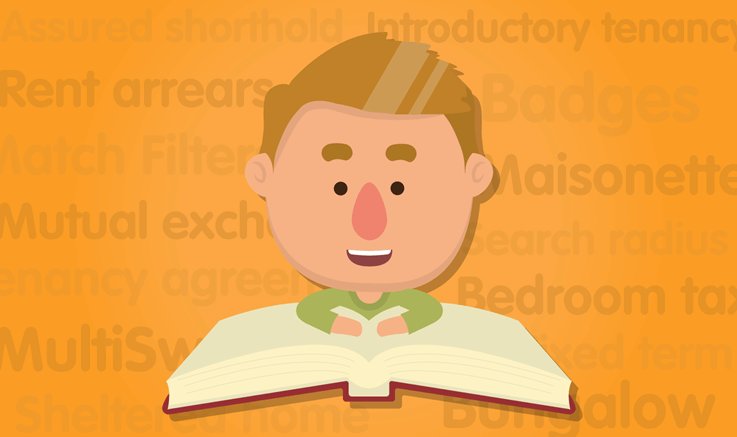
Here at HomeSwapper, we understand how the idea of mutual exchange can seem daunting to some swappers… finding that swap, going through the legal processes and finally, moving house. On top of this, there are many new technical terms to understand when it comes to mutual exchange. We recently heard from one swapper, who told us how much more difficult this makes the process. We want to help our swappers as much as possible, so we have created a simple guide to the new vocabulary you can expect to see:
HomeSwapper vocabulary
1. Home swap: a mutual exchange of homes between two (or more) social housing tenants. For in depth information on mutual exchange, please see our recent article here. [http://blog.homeswapper.co.uk/blog/2018/september/12/what-is-mutual-exchange/]
2. MultiSwap: a swap involving more than two homes, where a swapper moves into the home of a person who is moving into the home of another person, to create a chain effect. For in depth information on MultiSwaps, please see our recent article here. [hyperlinked to: http://blog.homeswapper.co.uk/blog/2018/july/31/how-to-use-the-homeswapper-multiswap-tool/
3. HomeSwapper Matches: a match is a property on HomeSwapper that has the elements that you are looking for and whose preferences match your property.
4. HomeSwapper match filters: your match filters are the elements you choose when you’re searching for a property. These could be location, number of bedrooms, additional features, etc.
5. HomeSwapper search radius: this is the search area you choose around your desired location. For example, you might choose for HomeSwapper to search 0.1 miles from a specific street, or you might choose for the site to include properties 20 miles around a specific street.
6. HomeSwapper badges: HomeSwapper badges are awards that swappers can get for actions, such as replying to all their messages, adding extra information to their advert, or to show that they’re a serious swapper. When looking at adverts these are a good indication of how you’re going to be able to interact with the other swapper.
Regulatory vocabulary
1. Tenancy agreement: The tenancy agreement is a contract between you and your landlord. It may be written or oral. The tenancy agreement gives certain rights to both you and your landlord, for example, your right to live in the accommodation and your landlord’s right to get rent for allowing you to live in the accommodation.
2. Rent arrears: if your rent is not paid, the money owed is called ‘rent arrears’.
3. Bedroom tax: was a change to Housing Benefit Entitlement that started in April 2013. It means those claiming housing benefit will receive less if they live in a housing association or council property that is thought to have one or more spare bedrooms. Having one spare bedroom will mean you will lose 14% of your entitled housing benefit and having two or more spare bedrooms will mean you will lose 25% of your entitlement.
Types of tenancy
1. Secure: most council tenants are secure tenants and a secure tenancy is a lifetime tenancy.
2. Assured: those with an assured tenancy have long-term tenancy rights. They will usually pay their rent to a private landlord and usually will have moved into their home between 1989 and 1997.
3. Fixed-term: a fixed-term tenancy is an agreement that will last for a pre-agreed period of time. It will usually last for at least 5 years, but the landlord will decide whether it’s renewed.
4. Assured shorthold: most private tenants are given assured shorthold tenancies, usually for 6 or 12 months. Your deposit will be protected and you must be given at least 2 months’ notice to leave.
5. Flexible: a flexible tenancy is a type of secure tenancy that only lasts for a fixed period.
6. Introductory: an introductory tenancy is a trial tenancy that allows the council to decide if you are a good tenant. Not all councils give introductory tenancies to new tenants.
7. Licence: you will either have a tenancy or a licence. The difference is that a licence gives you fewer rights against eviction.
8. Shared owner: a shared owner owns a part of the property and pays rent on the part that they don’t own to a housing association.
9. Starter: a housing association can give you a starter tenancy for a 12-month trial period before deciding whether to give you a longer-term tenancy.
Remember, if you aren’t sure of your tenancy type when you’re choosing it in HomeSwapper you can always check with your landlord!
Types of home
1. Detached house: a house with no other house attached to it – a stand-alone house.
2. Semi-detached house: a house that shares one wall with another house.
3. Terraced house: a house built as part of a row of houses that shares walls on both sides with other houses.
4. Bungalow: a low house with only one floor and occasionally, rooms set in the loft space.
5. Studio: a flat containing just one main room.
6. Maisonette: a flat that is typically over two floors of a larger building.
7. Sheltered home: this is rented housing for older, disabled or vulnerable people.
The HomeSwapper Customer Support team are always on hand to give advice and tips on how to get the most from HomeSwapper. They deal with Swappers every day and have a unique insight and view on the thousands of successful swaps that take place on HomeSwapper.






